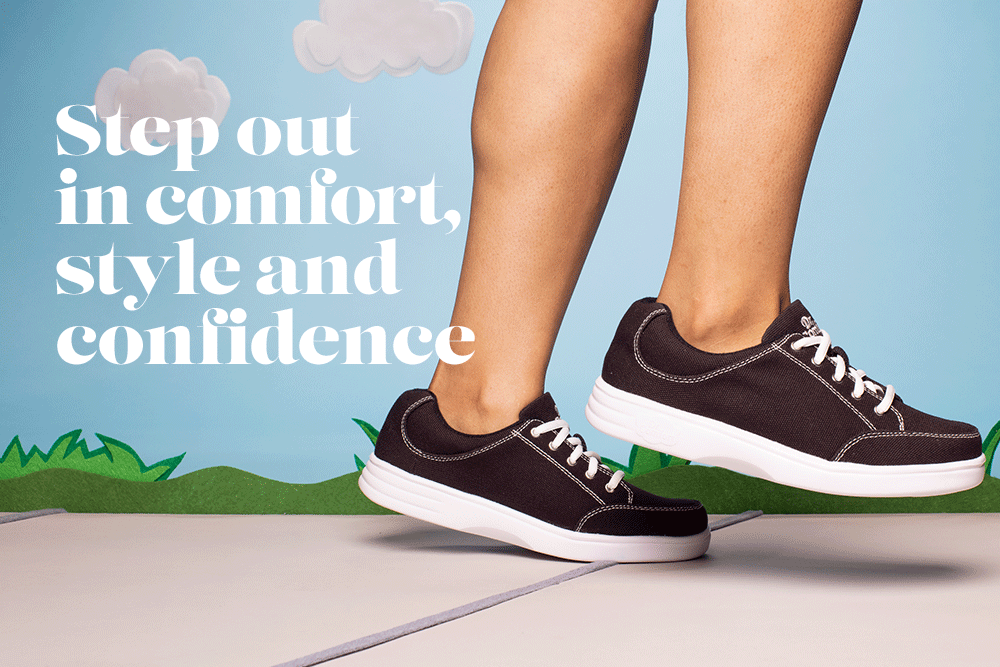What Are Diabetic Shoes? Key Features and Benefits
By: Jeanne Bellezzo

When you’re living with diabetes, you know it’s important to take especially good care of your feet. Taking good care of your foot health starts with smart decisions about proper footwear, ensuring you choose the most appropriate options for daily comfort and protection.
The shoes you wear can help make a big difference in your foot health and comfort. Regular shoes that offers little or no support, compresses your feet or toes, or puts pressure on vulnerable areas can contribute to potential problems ranging from foot ulcers and blisters to infections and other foot deformities.
The Importance of Therapeutic Footwear for Diabetics
Researchers in an Australian study recommended people with diabetes should be advised to wear footwear that fits, protects and accommodates the shape of their feet.1 “That’s where therapeutic footwear comes in,” says Brian Lane, Director of Education at Dr. Comfort®. “Specially designed and constructed to help protect your feet and provide exceptional comfort, diabetic footwear offers important features and benefits for people with diabetes.”
Beyond regular shoes, diabetics can benefit greatly from a variety of diabetic footwear, including slippers, boots, and sandals. Each type of appropriate footwear serves a distinct purpose in daily life, ensuring that diabetics can maintain foot health and comfort in all environments and activities.
Diabetic Slippers
Diabetic slippers might seem like a simple luxury, but for people with diabetes, they can be a vital component of diabetic foot care, especially at home. Diabetic slippers offer cushioning and protection, helping prevent injuries from bumps or hard surfaces.
With features like wide, non-constricting fits and soft interiors, diabetic slippers help keep your feet warm and well-supported, which is especially important for those with poor circulation. They also ensure you’re not walking barefoot, reducing the risk of stepping on small objects or experiencing temperature-related damage to sensitive feet.
Diabetic Boots
When colder months hit or rugged terrains are unavoidable, diabetic boots provide the protection and support necessary to prevent foot damage. These boots are designed with features like extra depth, wide toe boxes, and moisture-wicking materials to keep feet dry and warm while reducing the risk of pressure sores or blisters.
With their sturdy construction and extra ankle support, diabetic boots can help prevent falls and ensure stability when walking on uneven surfaces, making them a practical option for both outdoor activities and work-related environments.
Diabetic Sandals
Many people may think diabetic sandals aren’t suitable for diabetics, but diabetic sandals offer a safe, comfortable alternative for warm weather. Unlike typical sandals, which can expose the feet to potential injury, diabetic sandals feature protective straps, soft materials, and cushioned soles.
They provide excellent airflow to prevent excessive moisture buildup, while offering support and protection to prevent irritation or injury. With a secure fit, diabetic sandals reduce the chance of rubbing or chafing while allowing the toes to spread comfortably, making them ideal for beach outings or casual walks.
Key Features to Look For
When you’re shopping for therapeutic footwear, keep the following features in mind:
- Extra-wide widths: Extra width provides plenty of room for foot comfort, so the shoe doesn’t pinch or constrict nerves or impair circulation.
- Large toe boxes: A wide toe box helps reduce pressure on the foot and gives the toes room to stretch and relax without feeling cramped or restricted. It also helps reduce the risk of injury.
- Easy on/off closure systems: Laces, straps and hook-and-loop closures provide a secure, customizable fit, so the shoe is easy to slip on and off and adjust for comfort.
- Firm heel counter: A solid heel provides extra protection, support and stability.
- Padded tongue : Soft padding on the tongue helps prevent friction and improve overall fit.
- Extra-depth options: Extra depth shoes accommodates custom insoles and orthotics comfortably.
Diabetic footwear is designed not only to help with common foot issues, such as blisters, ulcers, or pressure points, but also to improve circulation and reduce nerve compression. This specialized footwear ensures that your feet remain well-supported and protected throughout the day, minimizing the risk of injury and allowing for a greater sense of mobility and independence.
“In addition, look for approval by the American Podiatric Medical Association (APMA),” says Lane.
Step Confidently into a Healthier Future with Diabetic Footwear
Dr. Comfort offers diabetic shoes for almost any need: casual, athletic, dressy and more – even boots and sandals. We use only the finest materials, technology and craftsmanship to help ensure quality and comfort.
Talk to your doctor or healthcare professional about whether Dr. Comfort shoes are right for you. In many cases, diabetic footwear may be covered by Medicare and supplementary insurance.
- van Netten JJ, Lazzarini PA, Armstrong DG, Bus SA, Fitridge R, Harding K, Kinnear E, Malone M, Menz HB, Perrin BM, Postema K, Prentice J, Schott KH, Wraight PR. Diabetic Foot Australia guideline on footwear for people with diabetes. J Foot Ankle Res. 2018 Jan 15;11:2. doi: 10.1186/s13047-017-0244-z. PMID: 29371890; PMCID: PMC5769299.
The contents of this blog were independently prepared, and are for informational purposes only. The opinions expressed herein are those of the author and are not necessarily indicative of the views of any other party. Individual results may vary depending on a variety of patient-specific attributes and related factors.1
